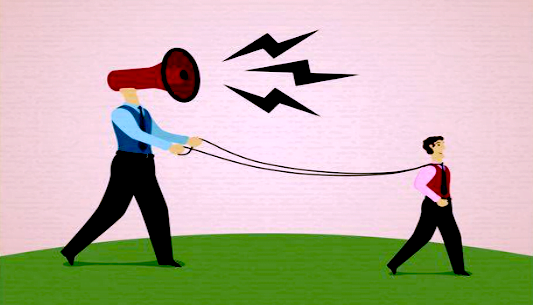
Imagine this scenario: you sign up to participate in a scientific study on memory and learning at a major university.
Your role is that of “Teacher,” and an “Experimenter” in a lab coat introduces you to your “Learner.”
You are then placed in front of an electric shock generator. Your Learner is seated in an adjacent room, where he is hooked up to electrodes. You can hear your Learner, but you cannot see him.
The Experimenter instructs you to provide your Learner with a series of word pairs. You are to test the Learner by naming a word and asking him to recall its partner/pair from a list of four possible choices.
If and when your Learner answers incorrectly, you are to administer a remote-controlled electric shock. The severity of the shocks increase with each subsequent wrong answer.
Your Learner answers the first few questions correctly, but then begins to falter. As he continues to provide incorrect answers, you are instructed to administer shocks of increasing intensity. The Learner begins to object to the jolts and shouts out in pain.
The Experimenter orders you to continue with the test and shocks and assures you that while the shocks may be painful, the Learner will suffer no permanent tissue damage.
Would you continue, or would you stop the experiment?
****
That is the question the late social psychologist Stanley Milgram set out to answer when he conducted the experiment described above.
His findings were surprising and disturbing: the tendency to obey authority figures is strong, no matter how harmful their orders are.
Milgram’s research on obedience to authority figures began in July 1961, in the basement of Linsly-Chittenden Hall at Yale University, three months after the start of the trial of German Nazi war criminal Adolf Eichmann.
Milgram’s series of psychological experiments was designed to answer a popular question at that particular time: “Could it be that Eichmann and his million accomplices in the Holocaust were just following orders? Could we call them all accomplices?” He wanted to investigate whether Germans were particularly obedient to authority figures, as this was a common explanation for the Nazi killings in World War II.
His findings were surprising and disturbing.
The Experiment
Milgram used a newspaper ad to recruit study participants. Respondents were told the purpose of the experiment was to study the effects of punishment on learning ability.
Three individuals were involved in each session: the Experimenter, who was the authority running the experiment; the Teacher (who was to obey the Experimenter’s instructions and was the actual subject of the experiment); and the Learner, who was an actor pretending to be a volunteer.
The subject and the actor both drew slips of paper to determine their roles, but unknown to the subject, both slips said “Teacher.” The actor would always claim to have drawn the slip that read “Learner,” guaranteeing that the subject would always be the “Teacher.”
After a brief introduction, the Learner was taken into a room and electrodes were attached to his arms, and the Teacher and Experimenter went into a room next door that contained an electric shock generator. Teacher and Learner could communicate, but could not see each other.
Prior to beginning the actual test, the Teacher was given a sample electric shock from the electroshock generator in order to experience firsthand what the shock that the Learner would supposedly receive during the experiment would feel like. The Teacher was then given a list of word pairs that he was to teach the Learner. The Teacher began by reading the list of word pairs to the Learner, and then would read the first word of each pair and four possible answers. The Learner would press a button to indicate his response. If the answer was incorrect, the Teacher was to administer a shock to the Learner, with the voltage increasing in 15-volt increments for each wrong answer. If correct, the Teacher would read the next word pair.
Shock levels were labeled from 15 to 450 volts. Besides the numerical scale, verbal anchors added to the frightful appearance of the machine. Beginning from the lower end, jolt levels were labeled: “slight shock,” “moderate shock,” “strong shock,” “very strong shock,” “intense shock,” and “extreme intensity shock.” The next two anchors were “Danger: Severe Shock,” and, past that, a simple but eerie “XXX.”
The Teachers believed that for each wrong answer, the Learner was receiving actual shocks. In reality, there were no shocks. After the Learner was separated from the Teacher, the actor switched on a tape recorder that was integrated with the electroshock generator. It played prerecorded sounds for each shock level.
After a number of voltage-level increases, the actor would begin to object loudly and bang on the wall that separated him from the subject. After banging on the wall several times and expressing concern over a heart condition, all responses by the Learner would cease. Teachers were instructed to treat silence as an incorrect answer and apply the next shock level to the Learner.
When Teachers asked to stop the experiment or expressed concern for the Learner, they were given a succession of verbal prods by the Experimenter, in this order:
- Please continue.
- The experiment requires that you continue.
- It is absolutely essential that you continue.
- You have no other choice, you must go on.
If the Teacher insisted on stopping after all four successive verbal prods, the experiment was terminated. If not, it was halted after the Teacher had given the maximum 450-volt shock three times in succession.
The Experimenter also gave special prods if the Teacher made specific comments. For example, if the Teacher asked whether the Learner could suffer permanent physical harm, the Experimenter replied, “Although the shocks may be painful, there is no permanent tissue damage, so please go on.” If the Teacher said that the Learner clearly wants to stop, the Experimenter replied, “Whether the Learner likes it or not, you must go on until he has learned all the word pairs correctly, so please go on.” If the Teacher asks who is responsible for any negative effects, the Experimenter replied, “I will take responsibility.”
Prior to conducting his research, Milgram asked Yale students and 40 psychiatrists to predict the outcome of the studies and found nearly universal agreement that virtually no one would continue to the end of the shock generator’s range. In subsequent investigations, people who were provided with more details about the procedure still estimated that obedience rates would be lower than those in the actual findings.
The Shocking Results
A few of the Teachers refused to continue with the shocks early on, despite urging from the Experimenter. This is the type of response Milgram expected as the norm.
But the overall results were surprising: in the first set of experiments, 65% of the Teachers were willing to give electric shocks of up to 450 volts – the maximum level – to their Learners. All of the participants continued to at least 300 volts.
Some test subjects paused at 135 volts and began to question the purpose of the experiment. Most of the Teachers showed signs of tension and nervousness, and some began to laugh nervously or exhibit other signs of extreme stress when they heard the screams of pain coming from the Learner. A few thought they had actually killed the Learner.
But some appeared cold, arrogant, robotic, and rigid throughout the experiment.
Milgram summarized the results in his 1974 article, The Perils of Obedience:
The legal and philosophic aspects of obedience are of enormous importance, but they say very little about how most people behave in concrete situations. I set up a simple experiment at Yale University to test how much pain an ordinary citizen would inflict on another person simply because he was ordered to by an experimental scientist. Stark authority was pitted against the subjects’ [participants’] strongest moral imperatives against hurting others, and, with the subjects’ [participants’] ears ringing with the screams of the victims, authority won more often than not. The extreme willingness of adults to go to almost any lengths on the command of an authority constitutes the chief finding of the study and the fact most urgently demanding explanation.
Ordinary people, simply doing their jobs, and without any particular hostility on their part, can become agents in a terrible destructive process. Moreover, even when the destructive effects of their work become patently clear, and they are asked to carry out actions incompatible with fundamental standards of morality, relatively few people have the resources needed to resist authority.
In general, Teachers were more compliant when (1) the authority figure was in close proximity; (2) Teachers felt they could pass on responsibility to others; and (3) experiments took place under the endorsement of a respected organization.
Milgram divided the participants into three categories:
- Obeyed but justified themselves. Some obedient participants gave up responsibility for their actions, blaming the Experimenter. If anything had happened to the Learner, they reasoned, it would have been the Experimenter’s fault. Others had transferred the blame to the Learner: “He was so stupid and stubborn he deserved to be shocked.”
- Obeyed but blamed themselves. Others felt badly about what they had done and were quite harsh on themselves. Members of this group would, perhaps, be more likely to challenge authority if confronted with a similar situation in the future.
- Rebelled. Finally, rebellious subjects questioned the authority of the Experimenter and argued there was a greater ethical imperative calling for the protection of the Learner over the needs of the Experimenter. Some of these individuals felt they were accountable to a higher authority.
Possible Explanations For the Participants’ Behavior
Milgram explained the actions of his participants by suggesting that people actually have two states of behavior when they are in a social situation:
- The autonomous state: People direct their own actions, and they take responsibility for the results of those actions.
- The agentic state: People allow others to direct their actions, and then pass off the responsibility for the consequences to the person giving the orders. In other words, they act as agents for another person’s will.
Milgram suggested that two things must be in place in order for a person to enter the agentic state:
- The person giving the orders is perceived as being qualified to direct other people’s behavior. That is, they are seen as legitimate.
- The person being ordered about is able to believe that the authority will accept responsibility for what happens.
Agency theory says that people will obey an authority when they believe that the authority will take responsibility for the consequences of their actions. This is supported by some aspects of Milgram’s evidence. For example, when Teachers were reminded that they had responsibility for their own actions, almost none of them were prepared to obey. In contrast, many Teachers who were hesitant to continue did so if the Experimenter said that he would take responsibility.
Study Variations
Milgram later performed several variations on his experiment:
- In one, the Learner was not only visible but Teachers were asked to force the Learner’s hand to the shock plate so they could deliver the punishment. Teacher obedience dropped to 30% in this experiment.
- In another variation, Teachers were instructed to apply whatever voltage they desired to incorrect answers. Teachers averaged 83 volts, and only 2.5 percent of participants used the full 450 volts available.
- For the original experiment, the Experimenter wore a grey lab coat as a symbol of his authority (a kind of uniform). Milgram carried out a variation in which the Experimenter was called away to take a phone call at the beginning of the experiment. The role of the Experimenter was then taken over by an “ordinary member of the public” – an actor in everyday clothes, rather than a lab coat. The obedience level dropped to 20%.
- A change of location was tested in another variation. The experiment was moved from the impressive Yale University laboratory to a set of run-down offices. Obedience dropped to 47.5%.
- When the Experimenter issued demands by telephone, Teachers were less likely to obey. But when the Experimenter returned to the lab, he was often able to induce the Teacher to comply.
- Conflicting authority figures stopped the action. When two Experimenters of equal status were both seated at the command desk and gave incompatible orders, Teachers stopped delivering shocks.
- Three Teachers (two actors and a real subject) administered a test and shocks in another variation. When the two actors disobeyed the Experimenter and refused to go beyond a certain shock level, most subjects followed: 7.5% of the participants refused to go on as soon as Teacher 1 quit, 30% refused to continue immediately after Teacher 2 quit, and only 10% continued to the end of the study.
- In a variation that Milgram called “a dilemma that is more common in everyday life,” Teachers did not administer shocks themselves: they merely performed the task of administering the word-pair test. Another person administered the shocks. In this experiment, 37 out of 40 adults continued to the highest level on the shock generator. They excused their behavior by saying that the responsibility belonged to the man who actually pulled the switch. Milgram commented, “This may illustrate a dangerously typical arrangement in a complex society: it is easy to ignore responsibility when one is only an intermediate link in a chain of action.”
In 1974, Milgram said:
With numbing regularity good people were seen to knuckle under the demands of authority and perform actions that were callous and severe. Men who are in everyday life responsible and decent were seduced by the trappings of authority, by the control of their perceptions, and by the uncritical acceptance of the experimenter’s definition of the situation, into performing harsh acts. A substantial proportion of people do what they are told to do, irrespective of the content of the act and without limitations of conscience, so long as they perceive that the command comes from a legitimate authority.
Current Research and Opinions
Dr. Thomas Blass is an expert on obedience to authority and the works of Stanley Milgram. When asked if Milgram would find less obedience if he conducted his experiments today, he says,
I doubt it. To go beyond speculation on this question, I carried out the following statistical analysis. I gathered all of Milgram’s standard obedience experiments and the replications conducted by other researchers. The experiments spanned a 25-year period from 1961 to 1985. I did a correlational analysis relating each study’s year of publication and the amount of obedience it found. I found a zero-correlation – that is, no relationship whatsoever. In other words, on the average, the later studies found no more or less obedience than the ones conducted earlier.
In 2006, Social psychologist Jerry M. Burger replicated Milgram’s experiment, with a few minor changes: He did not allow Teachers to exceed the 150 volt shock level due to ethical concerns, and he made some procedural adaptations that should have made it easier for the participants to resist authority. He selected the 150 volt mark because in Milgram’s experiments, 79% of the people who continued past 150 volts (26 of 33) went all the way to 450 volts – the end of the shock generator’s range. The 150-volt switch is something of a point of no return.
Burger’s results were nearly identical to Milgram’s: 70% of his participants were willing to continue with the next item on the test after reaching the 150 volt mark and had to be stopped by the Experimenter. This rate is slightly lower than the percentage who continued beyond the 150 volt point in Milgram’s experiment (82.5%), although the difference fell short of statistical significance.
Like Milgram, Burger found no difference in behavior among genders.
Burger evaluated the participants’ tendency to empathize. He found that while people who were high in empathic concern expressed a reluctance to continue the procedure earlier than those who were low on this trait, it did not stop them from continuing. This finding debunks the notion that a lack of empathy explains the high obedience rates in Milgram’s studies.
In his paper Replicating Milgram: Would People Still Obey Today? Berger discussed the possible reasons participants were so compliant.
He describes four features of the experiment that likely contributed to the high rates of obedience:
- Obedience to Authority: Our culture socializes individuals to obey certain authority figures, such as police officers, teachers, and parents. Milgram’s Experimenter was given the legitimacy of authority by virtue of his association with the experiment, the university, and possibly even science.
- Gradual Increase in Demands: An abundance of research shows that a gradual increase in the size of demands is an effective tactic for changing attitudes and behavior. In Milgram’s experiments, Teachers were asked to increase the intensity of the shocks in small increments. The well-demonstrated need to act and appear in a consistent manner would have made it difficult for a participant to refuse to press the 195-volt switch after just pressing the 180-volt switch.
- Limited Sources of Information in a Novel Situation: Because Teachers were placed in an unfamiliar situation with no additional information or resources, it was not unreasonable for them to defer to the Experimenter’s expertise, at least for a while. The Experimenter appeared to be an expert who was very familiar with the procedure and wasn’t alarmed by the Learners’ reactions to the shocks.
- Responsibility Not Assigned or Diffused: Absence of responsibility has often been cited by psychologists as a contributing factor to aggressive and abhorrent behavior. When Milgram’s Teachers asked about responsibility, the Experimenter specifically stated that he himself was responsible for any harm to the Learner. Milgram reported that many of his participants placed responsibility for their own actions on the Experimenter, taking a “just following orders” position in explaining why they continued the shocks. This was also demonstrated when Milgram varied the experiment by having the shocks administered by someone other than the Teacher who was reading the test to the Learner. The participants in this condition attributed responsibility for hurting the Learner to the person pressing the switches.
A new study published in the Cell Press journal Current Biology adds to Milgram’s work.
Researchers at University College London and Université Libre de Bruxelles in Belgium found that when someone gives us an order, we actually feel less responsible for our actions and their painful consequences.
Patrick Haggard of University College said he and his colleagues wanted to answer the following question:
Maybe some basic feeling of responsibility really is reduced when we are coerced into doing something. People often claim reduced responsibility because they were “only obeying orders.” But are they just saying that to avoid punishment, or do orders really change the basic experience of responsibility?
The researchers sought to measure the phenomenon called “sense of agency” that Milgram referred to when discussing his findings.
This is the feeling that one’s actions have caused some external event. For instance, Haggard explained, if you flip a light switch and a light comes on, you often experience those events as being nearly simultaneous, even if there’s a lag.
Previously, Haggard’s team has shown that people feel reduced sense of agency when their actions produce a negative versus a positive outcome. In other words, people literally perceive a longer lapse in time between an action (in this case, presses of a computer key) and its outcome when the end result is negative compared to when it is positive.
For the new study, the researchers measured sense of agency in the same way to explore changes in perception when someone delivered a mild electric shock to another person, either on orders or by their own choice. In other experiments, the harm inflicted on the other person was a financial penalty instead of a minor pain.
When the participants chose freely, they were encouraged along with the promise of a small financial gain. They also knew exactly what kind of harm they were inflicting because pairs of participants traded places with each other. Those who delivered shocks or suffered financial losses in some trial sessions received the same treatment in others.
The researchers reported that coercion led to a small but significant increase in the perceived time interval between action and outcome in comparison to situations in which participants freely chose to inflict the same harms.
In addition, they discovered that coercion also reduced the neural processing of the outcomes of one’s own action. The researchers concluded that claims of reduced responsibility under coercion could indeed correspond to a change in basic feelings of responsibility – not just attempts to avoid social punishment.
Haggard elaborated:
When you feel a sense of agency – you feel responsible for an outcome – you get changes in experience of time where what you do and the outcome you produce seem closer together.
He said it would be interesting to find out whether some people more readily experience a reduced sense of agency under coercion than others.
Milgram’s Legacy
Milgram created a documentary film titled Obedience showing the experiment and its results.
His findings have been replicated in a variety of cultures and most lead to the same conclusions as Milgram’s original study and in some cases see higher obedience rates.
Milgram debriefed his participants fully and disclosed the true nature of the experiments right after they were concluded.
He followed up with his subjects after a year to ensure that they suffered no long-term harm. The majority of them (83.7%) said that they were pleased that they had participated and that they learned something about themselves during the experiments.
Blass comments that:
We didn’t need Milgram to tell us we have a tendency to obey orders. What we didn’t know before Milgram’s experiments is just how powerful this tendency is. And having been enlightened about our extreme readiness to obey authorities, we can try to take steps to guard ourselves against unwelcome or reprehensible commands.
Here are some parting words from Milgram:
When an individual wishes to stand in opposition to authority, he does best to find support for his position from others in his group. The mutual support provided by men for each other is the strongest bulwark we have against the excesses of authority.
It may be that we are puppets-puppets controlled by the strings of society. But at least we are puppets with perception, with awareness. And perhaps our awareness is the first step to our liberation.
The social psychology of this century reveals a major lesson: often it is not so much the kind of person a man is as the kind of situation in which he finds himself that determines how he will act.
Disclaimer: We at Prepare for Change (PFC) bring you information that is not offered by the mainstream news, and therefore may seem controversial. The opinions, views, statements, and/or information we present are not necessarily promoted, endorsed, espoused, or agreed to by Prepare for Change, its leadership Council, members, those who work with PFC, or those who read its content. However, they are hopefully provocative. Please use discernment! Use logical thinking, your own intuition and your own connection with Source, Spirit and Natural Laws to help you determine what is true and what is not. By sharing information and seeding dialogue, it is our goal to raise consciousness and awareness of higher truths to free us from enslavement of the matrix in this material realm.
 EN
EN FR
FR

























